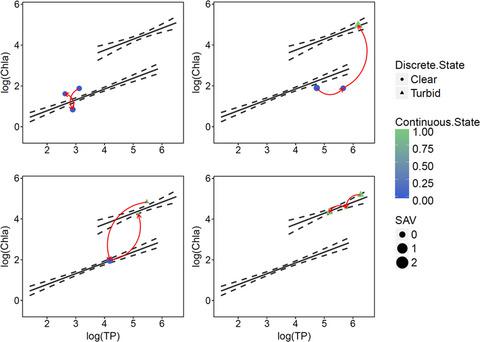当前位置:
X-MOL 学术
›
J. Appl. Ecol.
›
论文详情
Our official English website, www.x-mol.net, welcomes your feedback! (Note: you will need to create a separate account there.)
Using hidden Markov models to inform conservation and management strategies in ecosystems exhibiting alternative stable states
Journal of Applied Ecology ( IF 5.7 ) Pub Date : 2021-02-18 , DOI: 10.1111/1365-2664.13855 Kelsey Vitense 1 , Mark A. Hanson 2 , Brian R. Herwig 3 , Kyle D. Zimmer 4 , John Fieberg 1
中文翻译:

使用隐马尔可夫模型为表现出稳定状态的生态系统的保护和管理策略提供信息
更新日期:2021-02-18
Journal of Applied Ecology ( IF 5.7 ) Pub Date : 2021-02-18 , DOI: 10.1111/1365-2664.13855 Kelsey Vitense 1 , Mark A. Hanson 2 , Brian R. Herwig 3 , Kyle D. Zimmer 4 , John Fieberg 1
Affiliation

|
- Successful conservation of ecosystems exhibiting alternative stable states requires tools to accurately classify states and quantify state transition risk. Methods that utilize early warning signals are promising approaches for helping managers anticipate impending state transitions, but they require high‐resolution temporal or spatial data for individual sites, and they do not directly implicate causes or quantify their impacts on transition risk. There is need for a modelling approach that can assess state transition risk with lower resolution temporal data, identify drivers of state transitions and assess the impact of changes in these drivers on the persistence of ecosystem states.
- We developed a novel, integrated modelling framework that (a) classifies states in a way that reflects the qualitative dynamics of catastrophic regime shifts, (b) estimates state transition probabilities and (c) uses annual survey data to identify top predictors of state transitions and quantify their effects on transition risk. We applied our model to short time series from 123 shallow lakes that exhibit clear‐ and turbid‐water alternative stable states.
- We found that clear lakes were more likely to transition to the turbid state as total phosphorus levels increased or occurrence of submerged vegetation decreased. Additionally, increases in planktivorous or benthivorous fish biomass elevated transition risk. Too few turbid‐to‐clear transitions were observed to identify predictors of transitions in this direction.
- Synthesis and applications. Our study will inform conservation and management strategies for ecosystems exhibiting alternative stable states by providing a new tool to accurately classify states, compare state transition risk among sites based on resilience and system perturbations, and identify key variables to target to prevent undesirable transitions. Although we focus on shallow lakes as a case study for our modelling approach, we emphasize that our framework is applicable to any ecosystem known to exhibit alternative stable states.
中文翻译:

使用隐马尔可夫模型为表现出稳定状态的生态系统的保护和管理策略提供信息
- 要成功地展现出具有替代性稳态的生态系统,就需要使用工具来准确地对状态进行分类并量化状态转换风险。利用预警信号的方法是帮助管理人员预测即将发生的状态转换的有前途的方法,但是它们需要各个站点的高分辨率时空数据,并且它们不直接暗示原因或量化其对转换风险的影响。需要一种建模方法,该方法可以使用较低分辨率的时间数据评估状态转换风险,识别状态转换的动因,并评估这些动因中的变化对生态系统状态持久性的影响。
- 我们开发了一个新颖的集成建模框架,该框架(a)以反映灾难性政权转移的定性动态的方式对状态进行分类,(b)估计状态转移的可能性,(c)使用年度调查数据来确定状态转移的主要预测指标,以及量化其对过渡风险的影响。我们将模型应用于123个浅湖的短时间序列,这些浅湖表现出清水和浑水的替代稳态。
- 我们发现,随着总磷含量的增加或淹没植被的发生率的降低,清澈的湖泊更可能转变为浑浊的状态。另外,浮游或杂食鱼类生物量的增加也增加了过渡风险。观察到浑浊到清晰的转变太少,无法识别出该方向上的转变的预测因子。
- 综合与应用。我们的研究将通过提供一种新工具来准确地对状态进行分类,基于复原力和系统扰动比较站点之间的状态转换风险,并确定目标变量以防止不良转换,从而为表现出其他稳定状态的生态系统的保护和管理策略提供依据。尽管我们将浅湖作为建模方法的案例研究,但我们强调我们的框架适用于任何已知表现出稳定态的生态系统。



























 京公网安备 11010802027423号
京公网安备 11010802027423号